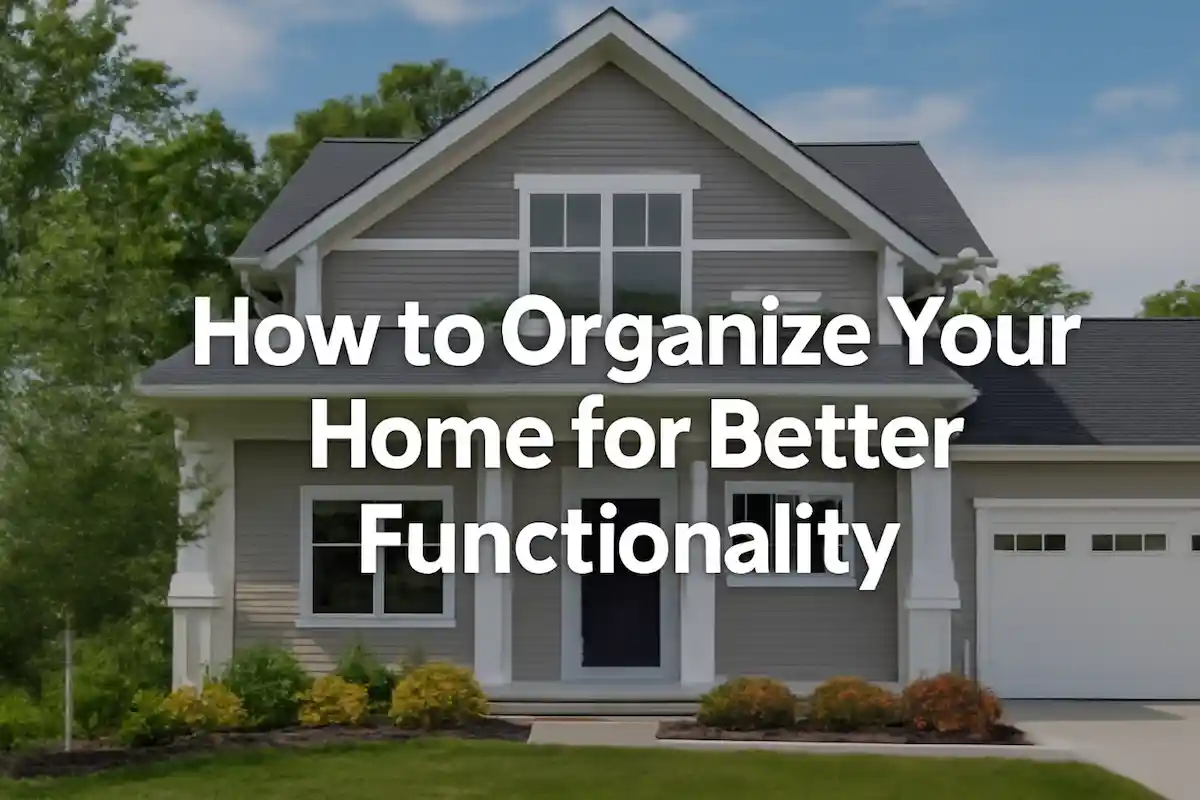Organizing your home for better functionality is a process that can make your daily life easier, more efficient, and less stressful. A well-organized home helps reduce clutter, improves the flow of daily routines, and ensures that every item has its place. Whether you’re dealing with small spaces or large homes, adopting a methodical approach can help create a more streamlined, functional living environment. By embracing key organizing principles and making use of proven strategies, you can transform your space into one that promotes productivity, peace, and comfort.
Decluttering: The First Step to a Functional Home
Decluttering is often the first and most essential step in organizing any home. Before you start arranging items or creating storage solutions, it’s important to go through each room and eliminate things that no longer serve a purpose. Decluttering not only frees up physical space but also clears your mind, making it easier to focus on tasks at hand. As you declutter, ask yourself if the item adds value to your life or if it can be donated, sold, or discarded.
The process of decluttering can be approached room by room, starting with high-traffic areas like the living room, kitchen, and bathrooms. You can use a “one in, one out” rule to prevent clutter from building back up. Make use of bins, baskets, and organizers to keep small items contained and avoid unnecessary accumulation. Remember, decluttering is a continual process that requires regular attention, but it is the foundation for creating a more organized, functional home.
Room-by-Room Organization for Maximum Efficiency
Once you’ve decluttered, it’s time to tackle room-by-room organization. This method is highly effective because it allows you to focus on one space at a time, ensuring that each area of your home is optimized for functionality. Start with rooms that require the most attention, such as the kitchen or home office, and work your way through the rest of the house.
For each room, think about the activities that take place there and organize accordingly. For example, in the kitchen, grouping similar items together—like spices, utensils, and appliances—can help reduce time spent searching for items during meal prep. In the bedroom, use storage solutions like under-bed bins or closet organizers to maximize space. Organizing each room based on its specific function will not only improve efficiency but will also make it easier to maintain cleanliness and order.
By organizing your home with thoughtful storage solutions and minimalist design, you can significantly increase its market value, making it more attractive to potential buyers.
Simplifying Spaces: How Minimalism Enhances Functionality
One of the most effective ways to organize your home for better functionality is by simplifying spaces. Minimalism focuses on keeping only the essentials and removing excess items that can cause visual and physical clutter. By simplifying your home, you can create more space for the things that truly matter. This approach not only makes your home more functional but also enhances the overall aesthetic of the space.
To embrace minimalism, start by evaluating what you truly need in each room. For example, in the living room, consider investing in multi-functional furniture like a storage ottoman or a sofa with built-in compartments. In the bedroom, opt for sleek furniture and minimize decorative items that don’t serve a purpose. This process allows you to focus on functionality and comfort, reducing distractions and helping to create a calming environment.
Storage Solutions: Maximizing Every Inch of Space
Storage solutions play a key role in improving home functionality. The right storage can help you keep your home organized and make your living space feel larger and more manageable. Whether you’re working with limited space or need to optimize a larger home, there are a variety of creative storage solutions to explore.
Consider using vertical space by installing shelves or cabinets that go all the way up to the ceiling. For small spaces like apartments, furniture with built-in storage—such as coffee tables with hidden compartments or ottomans with storage—can be a game-changer. Organizing systems like pull-out pantry shelves, drawer dividers, and closet organizers are excellent for maintaining order in areas that tend to accumulate clutter, such as the kitchen or bedroom. With the right storage solutions, you can maintain a clean, functional environment that allows you to easily find what you need.
Labeling: The Secret to Easy Access
Labeling is one of the most important, yet often overlooked, aspects of home organization. When every item has a designated place, it’s easier to find what you need and put things back where they belong. Labeling helps create a system that everyone in the household can follow, ensuring that your home remains organized long-term.
Whether you’re organizing kitchen items, seasonal clothing, or cleaning supplies, labels help identify where everything is stored. For example, use clear bins or containers for pantry staples and label them with the contents. In the garage, labeling toolboxes and storage bins can save you time when looking for specific items. When everything is clearly labeled, your home will be more functional, and tidying up will become a much quicker task.
Home Organization Tips for Better Functionality
When organizing your home, it’s important to have a few key tips in mind that can make the entire process more efficient and effective. Start by tackling one area at a time rather than attempting to organize the whole house in one go. This prevents overwhelm and allows you to see immediate results. Another important tip is to use containers and baskets to keep small items organized and prevent them from taking up valuable surface space.
For areas that are used frequently, like the entryway or kitchen, invest in convenient storage solutions that allow for quick access. Hooks, shelves, and baskets can help keep things organized and ensure that items are within reach when needed. A tidy, well-organized home promotes a functional living space and reduces the time spent searching for items or cleaning up.
A well-organized home not only improves functionality but also enhances its appeal, allowing you to sell at a higher price and attract more buyers in today’s competitive market.
Step-by-Step Guide to Organizing Your Home
A step-by-step guide to organizing your home can help break down the process into manageable tasks. Start by setting clear goals for each room and create a checklist for tasks like decluttering, cleaning, and organizing. For each area, prioritize the items that need the most attention, such as high-traffic zones like the kitchen, bathrooms, and living room.
Begin the organizing process with decluttering, followed by sorting and categorizing your items. Once everything is sorted, choose storage solutions that fit your needs. Finally, create a maintenance routine to ensure your home stays organized in the long run. By following a step-by-step guide, you’ll stay on track and avoid feeling overwhelmed.
The Role of Daily Routines in Home Organization
Daily routines play a significant role in maintaining a well-organized home. Setting aside a few minutes each day to tidy up or put things back in their designated spots can prevent clutter from building up. Small tasks, like making the bed, wiping down counters, or putting away dishes, can make a big difference in the overall functionality of your home.
Having a set routine also promotes a more mindful approach to consumption and organization. When everyone in the household is aware of the routine, keeping things organized becomes easier and more efficient. Daily routines not only maintain the organization but also encourage a culture of tidiness and responsibility among all family members, which leads to a more functional and enjoyable living space.
Organizing Challenges and How to Overcome Them
While organizing your home can be rewarding, there are inevitable challenges that may arise. One common challenge is maintaining order in high-traffic areas or shared spaces. These areas often accumulate clutter quickly, making it difficult to keep things tidy. To overcome this challenge, consider implementing a family-wide organizing system that encourages everyone to pitch in.
Another challenge is staying on top of seasonal changes or accumulating items over time. To address this, create a system for rotating seasonal items, such as holiday decorations or clothing, and make sure that older items are regularly donated or discarded. Keeping a routine of decluttering and organizing ensures that your home remains functional and free of excess clutter.
Budget-Friendly Organization Solutions
Creating a functional home doesn’t have to break the bank. There are plenty of budget-friendly organization solutions that can help you stay organized without spending a lot of money. Start by repurposing containers or items you already have around the house. Cardboard boxes, baskets, and jars can be used for organizing small items, and often you can find these at low or no cost.
Additionally, focus on DIY projects for organizing, such as creating your own shelving or closet organizers. Many online tutorials offer easy and affordable ways to build functional storage systems. A budget-friendly approach to home organization ensures that your living space is functional and aesthetically pleasing without draining your finances.





